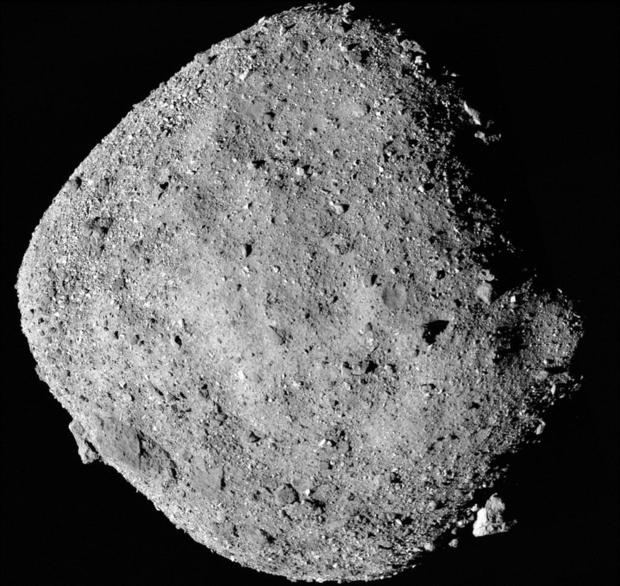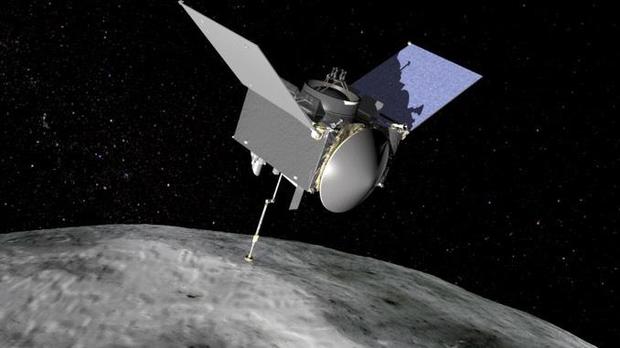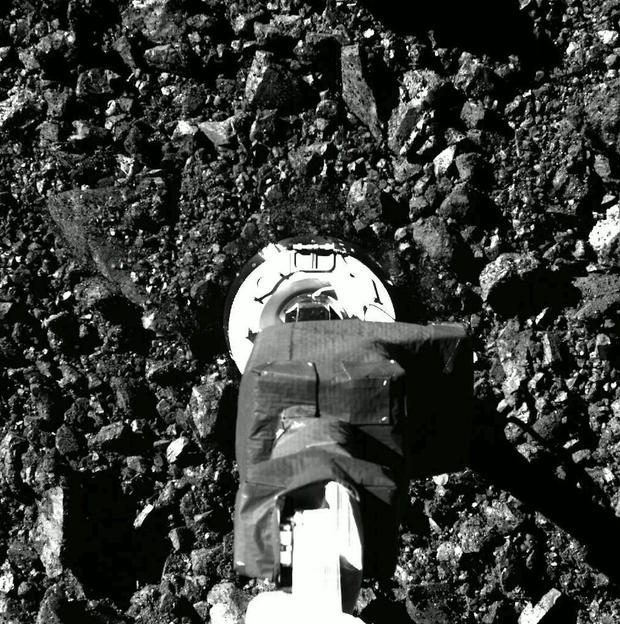NASA says samples from asteroid Bennu will land on Earth Sunday after fiery descent
A small saucer-shape capsule carrying a half-pound of rocks and dust collected from an asteroid called Bennu — leftovers from the formation of the solar system 4.5 billion years ago — is expected to slam into Earth's atmosphere at a blistering 27,650 mph on Sunday.
Extreme atmospheric friction will rapidly slow the craft while subjecting its protective heat shield to temperatures higher than 5,000 degrees, as the capsule decelerates along a trajectory toward a 37-mile-long landing zone at the Army's Dugway Proving Ground and Utah Test and Training Range.
Two minutes after entry, at an altitude of 20 miles, a small drogue parachute will deploy to stabilize and slow the craft before a 24-foot-wide main parachute unfurls 5,000 feet above the Utah desert.
From there, it's expected to descend to a gentle 11-mph touchdown at 10:55 a.m. ET, bringing a seven-year, four-billion-mile journey to an end.
After the sample capsule returns
Recovery crews will be standing by to document the condition of the sample capsule, looking for any signs of a breach that could cause contamination of the pristine samples inside, before moving it to a temporary air-filtered "clean room." It then will be prepared for a flight to the Johnson Space Center in Houston where NASA has set up a high-tech sample analysis laboratory.
"The asteroids that we have in our solar system today, they're left over from this earliest stage of solar system history," said University of Arizona Principal Investigator Dante Lauretta. "We're literally looking at geologic materials that formed before the Earth even existed.
"I call these the grandfather rocks, the ones that really represent our origins and where we came from. And I know they've just been waiting for four-and-a-half billion years to get into that sample return capsule, get down to the Utah desert safely (and) get to the amazing facility that our colleagues at Johnson Space Center put together."
Lauretta said the samples represent "a gift to the world."
"We have laboratories on four continents, 16 timezones, hundreds of researchers, over 60 laboratories that have been getting ready to get this material, and we are ready to begin the final science campaign of the OSIRIS REx prime mission."
What is OSIRIS-REx?
Two Japanese Hayabusa spacecraft returned small samples from asteroids in 2010 and 2020, but OSIRIS-REx — a convoluted acronym that stands for Origins, Spectral Interpretation, Resource Identification and Security Regolith Explorer — is the first American mission to collect an asteroid sample.
Equipped with three cameras, two spectrometers, a laser altimeter and an X-ray imaging system developed by college students, the OSIRIS-REx spacecraft and sample return capsule were launched atop a United Launch Alliance Atlas 5 rocket from Cape Canaveral on Sept. 8, 2016.
To reach Bennu, which orbits in a plane tilted six degrees from Earth's, OSIRIS-REx looped around the sun and then made a velocity-boosting gravity-assist flyby of Earth on Sept. 22, 2017. The spacecraft finally slipped into orbit around Bennu in late 2018.
Scientists were stunned at what they found. Instead of a more typical body, with fine-grained soils and rocks atop a solid interior, Bennu turned out to be a loosely compacted rubble pile that behaved more like a fluid than a solid.
"It's a stunning celestial object," Lauretta said. "To give you a sense of scale, it's a little over 1,600 feet in size. That's about the size of the Empire State Building. I like to think of Bennu as a small mountain floating in outer space.
"And its shape is particularly intriguing. it literally is a droplet made out of rock, gravel and boulders that are barely held together by their own microgravity."
After extensive mapping to identify a safe sample-collection point, OSIRIS-REx slowly descended toward the surface on Oct. 20, 2020, its pie pan-shaped "Touch-And-Go Sample Acquisition Mechanism," or TAGSAM, poised at the end of an 11-foot-long robot arm.
On contact, the probe fired a jet of nitrogen gas around the interior of the 12-inch-wide TAGSAM, stirring up the soil and small rocks underneath and blowing some of the material into collection filters before the spacecraft reversed course and backed away.
"It behaved very much like a fluid, there was no resistance to the downward motion of the spacecraft," Lauretta said in an interview. "We sank in about 50 centimeters (20 inches) and if we hadn't fired the back-away thrusters, I think we would have just gone right into the asteroid and disappeared."
After backing away from Bennu, the TAGSAM mechanism and its precious samples were stowed inside the OSIRIS-REx return capsule for the long flight back to Earth and Sunday's dramatic re-entry.
"Going back to the dawn of the solar system"
The flight plan calls for the return capsule to be released from the mothership at 6:42 a.m. ET. Twenty minutes later, the OSIRIS-REx spacecraft is expected to fire its thrusters, putting it on course for a close encounter with the asteroid Apophis in 2029.
Roughly 1,200 feet across, Apophis will come within 20,000 miles of Earth in 2029. The OSIRIS-REx spacecraft, by then renamed the OSIRIS-Apophis Explorer, will enter orbit around Apophis shortly after the asteroid's Earth flyby, kicking off extended observations.
But the Bennu samples coming back to Earth Sunday are the center of attention, and Lauretta can barely contain his enthusiasm.
"We're going back to the dawn of the solar system, we're looking for clues as to why Earth is a habitable world, this rare jewel in outer space that has oceans, it has a protective atmosphere," he said. "We think all of those materials were brought by these carbon-rich asteroids very early in our planetary system formation."
"And of course, the biggest question, the one that drives my scientific investigations, is the origin of life. What is life? How did it originate? And why was the Earth the place that it occurred? ... We believe that we're bringing back that kind of material, maybe representatives of the seeds of life that these asteroids delivered at the beginning of our planet."









